Coody Flips Script on Choking
Charles Coody's holds off Jack Nicklaus and Johnny Miller in 1971 Masters
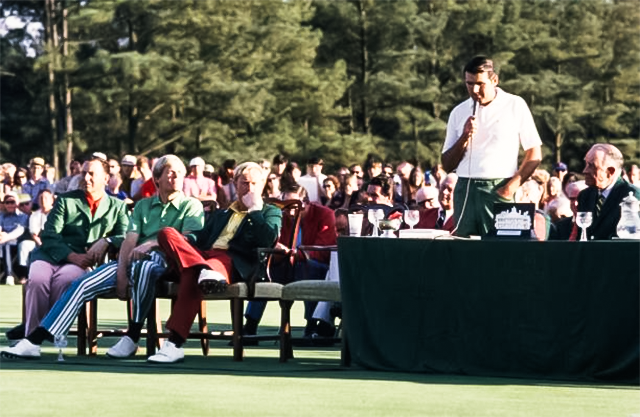
It’s the most magical week of the year in men’s professional golf and the Tour Backspin journey through the past celebrates with a massive deep dive into the 1971 Masters won by Charles Coody. Scroll down to see how the week, and the exciting final round played out. Be sure to check out the funny Augusta caddie tale in the Bonus Story.
PAST TOUR BACKSPIN ARTICLES ON THE MASTERS
A tradition I do each year for the Masters is an excerpt from my book on Tony Lema “Uncorked, The Life and Times of Champagne Tony Lema” and the 1963 Masters.
Tommy Aaron goes from bridesmaid to Masters champion in 1973.
Jack Nicklaus becomes the first Master champion to repeat and put on his own green jacket in 1966.
This edition of Tour Backspin was done while on the road, and I apologize in advance for any increase in typos. Thank you to premium subscribers who help support the research I do including at Augusta National on Wednesday.
Enjoy the Masters this week as we watch history unfold before our eyes.
Tour Backspin is a reader-supported publication. To receive new posts and support my work, consider becoming a free or paid subscriber. Save 20% on annual subscriptions during our Masters Sale (4/3/25 - 4/14/25)
Brian Harman overcame tough conditions on Sunday, as well as a heavy heart, to capture the The Valero Texas Open. We’ve got some of the action in the Clips I Loved, and I also give my take on the tournament in the PGA TOUR Wrap-Up. Scroll down to read.
I got access to a Wednesday pass to the Masters this year through my membership in the Golf Writers Association of America. This was my first trip to the Masters and I couldn’t wipe the smile off my face all day. Have you ever been? Let us know in this week’s The Tour Backspin Poll. We’ve got Van Morrison performing “Wild Night” in this week’s Music Clip. Watch the theatrical trailer for the 1971 film, “Sometimes A Great Notion” starring Paul Newman and Henry Fonda in the Tour Backspin Goes To The Movies. Masters artwork is featured in the Vintage Ad from 1959. Scroll down to view.
Check out the Tour Backspin Golf Shop Masters Sale going on now through Monday, April 14th, 2025. Visit the Golf Shop HERE.
The latest episode of The Tour Backspin Show has dropped. Host Larry Baush (me!) talks with Bruce Devlin and Mike Gonzalez about their podcast Fore The Good Of The Game. It’s a video podcast and is available on Substack and YouTube. Please subscribe to The Tour Backspin Show on YouTube and help us reach the threshold of subscribers needed to qualify for revenue.
The Tour Backspin Poll
In last week’s Tour Backspin Poll we asked you what you thought about Alejandro Tosti’s antics during the final round of the Texas Children’s Houston Open. All respondents thought that Tosti was being a jerk.
This week we want to know if you ever attended the Masters. Let us know in this week’s Tour Backspin Poll.
We’re playing Masters trivia in this week’s Tour Backspin Quiz. Scroll down to take the challenge.
Did you miss a previous newsletter? You can view it HERE. Help us grow Tour Backspin! Please forward this email to a friend. Was this newsletter forwarded to you? You can sign up HERE.
Okay, we're on the tee, let's get going.
Enjoy!
Larry Baush
Charles Coody Flips Script on Choking
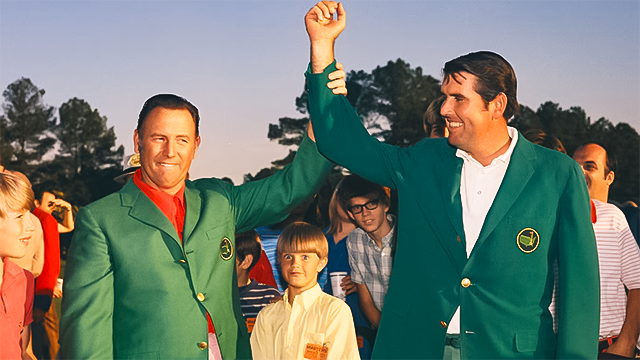
It is the Monday before the start of the 1981 Masters and an article in the Atlanta Journal, under the byline of staff writer Teague Jackson, highlights the confidence that amateur Steve Melnyk feels for the upcoming week. Melnyk qualified by winning the 1979 U.S. Amateur which earned him a Masters invitation in both 1980 and 1981.
“I’m putting so good now, I’m super-confident,” Melnyk told Jackson. “I just figure I’m gonna make everything from six feet in. You can’t believe what wonders that does to the rest of your game.”
“What happens to me if I should win here, then turn pro?”
He even mused on how the PGA TOUR (known as the Tournament Players Division or TPD during this era), would handle him winning the Masters and then him turning pro and playing on the tour under the exemption that would come along with the green jacket. Especially if he attempted to win his card at Q-School and was unsuccessful. Would he still be able to play with the exemption earned at the Masters as an amateur?
“What happens to me if I should win here, then turn pro?” he asked Jackson.
It was not such a far-fetched idea as Melnyk had put up some impressive finishes when playing against the pros at events such as the Greater Jacksonville Open and Sea Pines Heritage Open. Still, many dismissed out of hand the possibility of an amateur winning a green jacket.
Also on Monday, the field was set for the 35th annual Masters set to start on Thursday. Dave Eichelberger, Johnny Miller, Jerry Heard, Gibby Gilbert, Tom Shaw, John Schlee, Lou Graham, and Hale Irwin punched their tickets to the Masters based on points earned during the regular tour events. The Masters took eight players not otherwise eligible for invitations through this point system.
“I’m going to win it. It’s just that simple. I’m going to win the Masters.”
Steve Melnyk was not the only player coming into the week brimming with confidence. Dave Hill flat out declared that he would be wearing the green jacket on Sunday evening.
“I’m going to win it,” Hill told reporters after he spent almost a week practicing at Augusta National. “It’s just that simple. I’m going to win the Masters. They may not be ready for ol’ Davy, but it’s going to happen.”
This kind of bluster was par for the course from Hill who was no stranger to controversy in his 13-year career that included multiple fines and suspensions. Later in the year, he filed an antitrust suit against the tour after being fined and placed on probation for conduct unbecoming a professional after he was disqualified for signing an incorrect scorecard at the Colonial National Invitational.
“Nicklaus doesn’t need any more practice. He’s ready.”
Although Melnyk was confident about his own chances, he was really sold on the chances of Jack Nicklaus who was looking for the second leg of the grand slam after he won the PGA Championship in February.
“I played four practice rounds with Jack,” Melnyk informed reporters. “He messed around a lot, teaching me tricks now and then, and he still ripped the course limb from limb. Nicklaus doesn’t need any more practice. He’s ready.”
Nicklaus was in total agreement telling reporters, “I’m keyed up for it. I’m ready.”
He was focused on winning all four majors, attaining a professional grand slam that had never been achieved. He arranged his schedule, and his mindset, with preparations for the majors his focus. He had only played in five events prior to the Masters and had been on the grounds of Augusta practicing for nearly a week.
“It’s no secret I’d like to win them all,” he said. “I think a sweep is possible. I really think it can be done.”
Billy Casper, the defending Masters champion, was also confident about his chances at repeating.
“I’m a little more relaxed this year in my approach to the Masters,” he told Jackson of The Atlanta Journal. “You can afford to be when you’re defending champion. Who knows? Now that I’ve finally won it once, maybe I can win it ten times.”
“I’m playing absolutely the best golf of my life.”
Arnold Palmer, winner of two events on the 1981 schedule, could not be counted out as a favorite.
“I’m playing reasonably well,” he told reporters. “You always manage to get up for the big ones. I haven’t won a major title since 1964. That’s on my mind. I’ve worked very, very hard on my game this year and it seems to be coming along. Now, it’s just a matter of trying to keep everything together, to keep it where I want and hope it to be.”
Gary Player was also confident saying, “I’m playing absolutely the best golf of my life.”
Other favorites included Gene Littler, who lost a playoff to Casper in 1970, Tony Jacklin, the reigning U.S. Open champion, Miller Barber who was in the second position behind Palmer on the leading money winner list, Julius Boros, and Tom Shaw, winner of two titles so far for the season.
Augusta National, drenched in rain on Monday, was drying out fast by Wednesday aided by a strong wind. Most players tried to fit in nine holes of practice before the start of the par-3 contest. Dave Stockton won the par-3 contest after he birdied the first playoff hole against Orville Moody and Tom Weiskopf when they all tied with a 23, four under par. Jerry Heard may have provided the most entertainment as he recorded a one-under 26 despite making five birdies.
The intense practice, the socializing under the large oak tree, and the fun banter that fans enjoyed during the par-3 contest came to an end as players now focused on Thursday’s opening round.
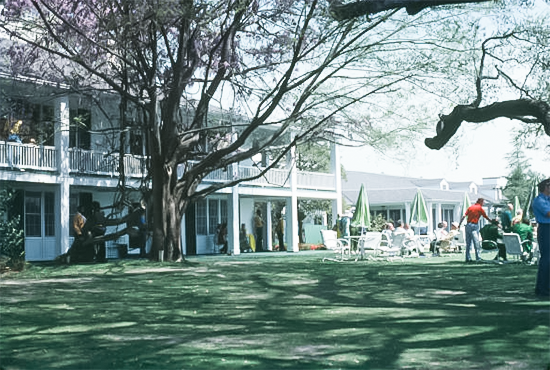
Round One
It is 9:10 in the morning on Thursday, April 8th, and patrons are crowded around the first tee. They gathered to watch the honorary starters, Jock Hutchinson, winner of the 1920 PGA Championship, and the 1921 Open Championship, and Fred McLeod, winner of the 1908 U.S. Open. The 35th annual Masters was underway after the two legends slapped drives down the first fairway. Bob Murphy launched the first official shot at 9:17. He would be followed by 76 other players, one of the smallest fields in recent years.
Despite the round being played under brilliant sunshine and with little to no wind, scoring was difficult. One reason was the pin placements which many players had difficulty accessing.
“They were difficult,” Nicklaus said after his round of 70. “You couldn’t shoot at half of them.”
Another reason for the high scores was the lengthening of the two par-5 holes on the back nine, the 13th and 15th holes. Many players laid up short of the water trouble on both holes while many of those who went for the green in two wound up in the water. The 15th hole did not give up an eagle the entire round, a rarity on a hole where many threes were posted in recent years.
Charles Coody had some scar tissue from past Masters performances. In 1969 he held a one-shot lead with three holes to play only to bogey each hole in. The next year, he entered the final round three strokes off the lead before shooting a 77 in the final round to finish T12. He began his attempt to flip the script in 1971 by grabbing the first-round lead with a stunning 66 that put him three clear of his nearest pursuers, Hale Irwin, Raymond Floyd, Bob Murphy, Bob Lunn, and Don January.
“I’m four strokes back, but there’s three rounds to go.”
Jack Nicklaus was another shot back, tied with Dale Douglass, but his round was marred by three putts at the final two holes.
“It wasn’t a good round. It wasn’t a bad round,” Nicklaus said to reporters. “But those two missed putts kept it from being good. I’m four strokes back, but there’s three rounds to go.”
Arnold Palmer came in with a disappointing 73 including a double bogey on the 10th hole, a result of a three putt.
“I played atrociously,” he admitted. “It’s the worst round I’ve had all year. I can’t think of anything I did well. I drove poorly and I hit a lot of bad irons. I made a couple of putts, but I missed a couple of short ones, too.”
Defending champion Billy Casper opened his defense with an even-par 72, while Tom Weiskopf came in with a 71 and Johnny Miller opened with a 72.
Second Round
Coody birdied the third hole in the second round to go seven-under par and seemed in control of his game. Then he double bogeyed the par-3 6th hole and finished the front nine with a 39. It looked as if he was going to repeat his Augusta playbook of wilting under the pressure whenever he found himself in the lead.
“There are just some days when you feel like you can do whatever you want with the golf course. Then, of course, there are the other kind of days.”
But he turned his round around on the back nine coming in with a 34 to minimize the damage posting a 73 that put him one-shot behind Don January who shot a second straight 69. Bob Murphy fired a 70 and was tied with Coody. Weiskopf added a 69 to sit at 140 while Nicklaus, with a 71, and Gene Littler, with a 69, were tied with Dale Douglass (71) and Hale Irwin (72) at 141. Johnny Miller was far down the leaderboard at 145 after a second-round 73.
“I simply played very poorly at the start,” Coody told Mickey McCarthy, sportswriter for The Atlanta Constitution. “I consider myself lucky to get out with a 73. It was a very erratic round. There are just some days when you feel like you can do whatever you want with the golf course. Then, of course, there are the other kind of days. And, I think it’s sometimes difficult to come back after a good subpar round like I had yesterday.”
“My goal this year is to win $65,000. Win that much and go home.”
Other than going bogey-bogey at the 11th and 12th hole, January was solid as a rock in his round. He birdied three holes on the front nine and added two on the back nine on his way to a 69.
January told reporters that he had a plan for the year saying, “My goal this year is to win $65,000. Win that much and go home.”
The second round again enjoyed sunny weather with clear skies, and just a light wind. President Carter watched some of the action at the top of the bleachers at the 15th green, but had to depart before play ended to travel to Atlanta to throw out the first pitch at the Braves home opener later Friday evening.
Third Round
Coody came out the gate hot in Saturday’s third round, again played in gorgeous weather, and caught January with a birdie at the third hole. He then added an eagle two at the 7th hole and birdied the 9th hole to go out in 33. At one point in his round, Coody held a four-shot lead after getting to 10-under.
He stumbled coming home on the last three holes making one wonder if the demons that remained from his finish in the final round of 1969, that cost him a green jacket, had not been vanquished. After three putting the 14th hole for a bogey, Coody finished with another three-putt at the 16th hole for bogey, and added another bogey at the 17th. He parred the final hole for a 70, seven-under par, and a total of 209.
While Coody began to fade, Nicklaus attacked Augusta National and worked his way into a share of the lead with a 68 tied with Coody. Nicklaus played the front nine as he had played all week with a streak of pars offset by two birdies at the par-5 holes where he chipped his third shots close. After missing the green left at the 10th hole, he ran his chip up the hill to 15-feet and saved his par by holing the tricky putt.
“It would be impossible not to know a man like Nicklaus is gaining on you.”
Nicklaus really started to turn it on as he reached the part of the course televised by CBS. He birdied five of six holes starting at the par-3 12th hole. He really got fired up when he hit a wedge second shot at the par-4 17th hole. He took off running before the ball had even landed as he knew it was a good one, and he was correct. He made the uphill birdie putt to go to eight-under and a one-stroke lead over Coody.
After driving into the bunker on the 18th, he flushed an 8-iron over the green and made bogey to finish at seven-under and was speaking with reporters as Coody finished his round.
“What did he finish with?” Nicklaus asked.
“Seven-under,” came the answer from one of the reporters.
“What am I?” Nicklaus asked.
“Seven-under,” another reporter said.
“Oh, good.”
Coody knew he had his work cut out for him playing against Nicklaus.
“It would be impossible not to know a man like Nicklaus is gaining on you,” he admitted after his round.
Don January struggled in his round and came in with a 73, two shots off the lead. Hale Irwin, with a third-round 71, and Tom Weiskopf, with a 72, were tied at 212 while Johnny Miller had a fine 68 and was another shot back at 213. With a 71 and a three-day total of 216, Arnold Palmer was too far back to foster any hopes of capturing the green jacket for this year.
The Saturday crowds were much larger than on Thursday or Friday.
Fourth Round
Jack Nicklaus arrived at Augusta National for the final round on Sunday, another beautiful day with sunny skies, wearing a pale-yellow shirt and red pants, and a tremendous feeling of confidence.
“I came out here today eager and thinking I was going to win,” Nicklaus later said. “When I birdied one, well, I thought, all is going to plan.”
Charles Coody arrived in a different state of mind, especially once the action started.
“I felt nervous and keyed up when I started,” he explained to reporters later.
Johnny Miller arrived in a flashy green ensemble including green striped pants and a green shirt, and dreams as wild as his outfit.
Coody played with Tom Weiskopf and had Miller, playing with Hale Irwin, in the group directly in front of him. Nicklaus, playing with Don January, was in the pairing just behind Coody. Miller started the round four shots behind Coody, but he was about to catch fire and insert himself into the intrigue of who would win the green jacket.
Miller began his charge up the leaderboard by shooting a 33 on the front nine before making the turn and facing the challenges of Amen Corner. He birdied the 11th, and then hit his tee shot into the front bunker at the par-3 12th. He had a lousy lie in the face of the bunker with his ball half buried. He dug the ball out with very little follow-through and the ball hopped out of the bunker, bounced a couple of times and then rolled into the cup for the most unlikely birdie you’ll ever see at the 12th hole.
Miller climbed out of the bunker and walked past Frank Hannigan, of the USGA and the walking official for the group, who had his mouth agape in slack-jawed amazement at what he had just witnessed. Miller was excitedly walking in circles on the green with upraised arms and waving to the patrons back at the tee. It was his fifth birdie of the round, and it put him into a tie for the lead with both Moody and Nicklaus.
Click on image to open video player on the web (Augusta National)
Miller added another birdie at the 14th which gave him a two-shot lead over Nicklaus who hit his ball in Rae’s Creek at the 12th hole and made a gutty bogey after playing his second shot from the mud. Coody was cruising along with pars through Amen Corner before he stumbled with a bogey on the 14th hole.
Click on image to open video player on the web (Augusta National)
Coody bounced back on the next hole, the par-5 15th, when he made a great up-and-down from above the bunker on the right side of the green for a birdie. He and Miller were now tied, Nicklaus was one behind.
Nicklaus missed the 15th green to the right and could not get up-and-down for his birdie wasting a good opportunity to put the pressure on Miller and Coody, and he remained one behind the leaders.
Coody hit his tee shot at the par-3 16th hole, the same hole where his collapse began in 1969, to 15-feet from the hole and ran the birdie putt in. He now held a one-shot lead over Miller. Miller managed to get a par on the 17th hole, but hit an errant tee shot at the final hole. His second shot missed the green to the right and he left his chip shot short of the pin. He missed the putt for par tapping in for a round of 68 for a total of 281.
“Sure, there was a lot of pressure. I felt it.”
Coody missed the green at the 17th but played a masterful bump-and-run shot to gimmie range for his par. Nicklaus could not secure a birdie on the back nine on his way to a 37 and a round of 72 for a total of 281, tied with Miller.
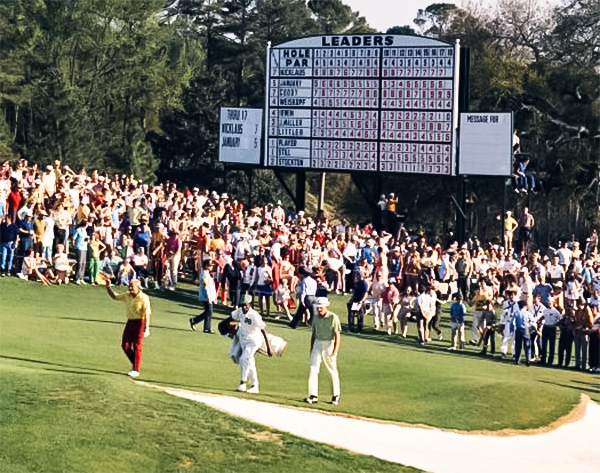
With a two-shot cushion, Coody played the 18th hole in regulation and captured the green jacket that was so elusive in 1969. He finished with a round of 70 and a four-day total of 279.
“Sure, there was a lot of pressure,” Coody said with a big, toothy smile. “I felt it. But I don’t think it was like the pressure of the 1969 tournament. I was the leader, and I think I felt something different. But today, John Miller got the lead, and I was the one trying to make up ground.”
“I found myself walking along thinking about how that green coat was going to look on me.”
This was the first time that Johnny Miller had been in contention at a major and it was a learning experience for him as he admitted that he had gotten a little ahead of himself.
“I ought to know better,” Miller admitted after his round. “I found myself walking along thinking about how that green coat was going to look on me.”
Nicklaus was a bit bewildered about his day saying, “Everything I thought would happen today happened exactly opposite from the way I figured they’d happen. I think I must have been too relaxed, too confident, when I started out.”
Coody won $25,000 along with the green jacket, Miller and Nicklaus both won $17,500 while Don January and Gene Littler tied for fourth and each won $9,550. Tom Weiskopf, with a final round 72, Ken Still, and Gary Player, who both had a 69, tied for sixth at 284 and won $5,600 each.
Steve Melnyk’s confidence at the start of the week was rewarded as he captured low amateur honors with a four-day total of 292.
But it was the pro from Abilene, TX, Charles Coody, who put his collapse in 1969, when he lost the green jacket with bogeys on the final three holes, in his rearview mirror. As the 1970 champion, Billy Casper, helped Coody into the green jacket, the new champion had a look of satisfaction and pride.
Coming Next Week: Davis Love III is gifted the 1987 Heritage Classic.
BONUS STORY
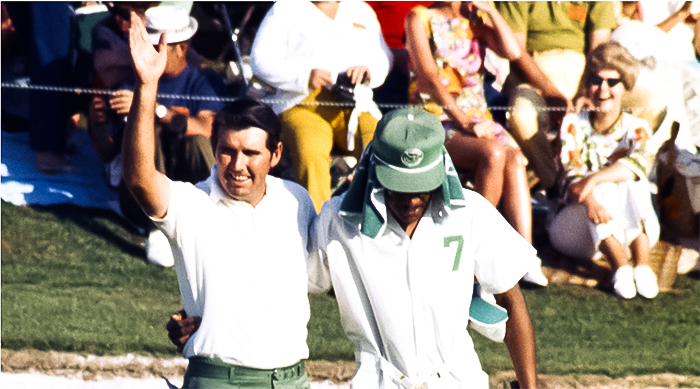
Charles Coody’s caddie, “Cricket” Pritchett, Dons Desguise
Walter “Cricket” Pritchett was relaxing at home at 924 Hightower in Atlanta, GA, in the middle of March 1971. He was sitting on his couch, next to his wife, watching the golf action from the Florida Citrus Open, won by Arnold Palmer. He turned and looked at his wife, a schoolteacher at Margaret Fain Elementary School in Atlanta, and he had one request—he wanted to caddie in just one more men’s professional golf event.
Cricket had been a caddie on the PGA TOUR and thirsted for one more chance to be a member of a player-caddie team. Maybe he could win just one more event.
“We were watching the Orlando tournament on TV,” he informed Jesse Outlar, Sports Editor at The Atlanta Constitution. “and I told her that I just had to do one more tournament. You see, I was on the tour for six years. I caddied, chauffeured, and was a valet for Doug Sanders for two and half years. When he started playing poorly, we didn’t get along so good, so I quit him.
After I left Doug, I caddied for Billy Casper when he won at Greensboro. I caddied in the Masters for Jacky Cupit in 1968 and for Charles Coody in 1969.”
“What time does the television coverage begin?”
So, Cricket called Freddie Bennett, the caddiemaster at Augusta National to see if he could get a bag. When Charles Coody saw that Cricket was available, he requested him for the week. Cricket drove a bus for the newly formed Metropolitan Atlanta Rapid Transit Authority (MARTA) and would have to find a way to get the time off. He came up with the idea of telling his boss that he needed to visit his sick grandmother in Houston.
On Saturday, Cricket and Coody found themselves in the lead at the Masters. With Jack Nicklaus and Johnny Miller nipping at his heals, they were waiting for the green to clear on the par-5, 8th hole. Coody studied the shot, but Cricket had something else on his mind.
“What time does the television coverage begin?” Cricket asked.
The thought crossed Coody’s mind that that was a strange question. When Coody asked him why he wanted to know at that point in the round, Cricket confessed about his lie to the boss and voiced concern over being caught in a television shot of the action. The quick-thinking caddie came up with a solution.
“I’ll be back at work in the Atlanta Transit System at 4am Monday morning.”
As the pair came into the range of television coverage, Cricket took the green towel from Coody’s bag and draped it over his head, fitting his caddie ball cap down over the top. He wore it that way in both the third and final rounds once the action reached Amen Corner and the television coverage.
“I guess it doesn’t matter now,” Cricket admitted to Outlar of The Atlanta Constitution when the writer caught up with him outside the locker room after Coody captured the green jacket. “The story is out. They’ll know I was here. I’ll be back at work in the Atlanta Transit System at 4am Monday morning. You see, when you take off they put your name at the top of the board for early duty.”
Cricket told Outlar that he figured he would be paid between $3,500 and $4,000 for his work that week. He planned to use the money as a down payment on a new house that he and his wife had their eyes on.
Not a bad week for a guy that just wanted to caddie in one more tournament. Charles Coody was sure glad he picked the 1971 Masters as the one tournament for his comeback and Cricket was equally happy that Charles Coody picked him as his caddie. Even if it meant that he had to resort to a disguise, one that in the end didn’t work.
(h/t to Clayton Ward, author of “The Legendary Caddies of Augusta” who will be featured in an upcoming episode of “The Tour Backspin Show.”
Tour Backspin is a reader-supported publication. To receive premium content including early release of The Tour Backspin Show, please consider upgrading to a premium subscription for just $36 28.80 per year during our Masters Sale.
WHAT HOLE IS IT?
Congratulations to John Lewis III, winner of the WHAT HOLE IS IT? contest. He correctly identified #16 at TPC San Antonio, Oak Course, in San Antonio, TX. John beat out six other correct answers in the drawing and we’ve got a gift discount code to The Tour Backspin Golf Shop coming his way. We are sending discount codes to the winners of WHAT HOLE IS IT? in 2025 so that they can choose their prize from the offerings in The Tour Backspin Golf Shop, including the Tour Backspin 19th Hole Hot Sauce. Multiple winners can combine their discount codes to use on a single order, and the codes never expire. When the code is redeemed, the prize will be sent with free shipping, so getting your prize will not cost you anything. Check out The Tour Backspin Golf Shop HERE.
The Herbert C. Leeds Trophy has been sent to the 2024 winner, Doug Posten, and we expect a picture of his victory pose soon.
We understand if a premium subscription isn’t in the budget, and we’re happy to have you here however you’ve arrived. You can sign up for a free subscription so you’ll never miss the newsletter. It will arrive in your inbox every Thursday. Paid subscribers help fund the work we do here at Tour Backspin. Save 20% on an annual subscription during our Masters Sale.
We told you about getting our hands on a treasure trove of film that we are cleaning up and digitizing for the Tony Lema documentary. Some great footage of Tony in action and even home movies. Below is a clip from the Howard Cosell Champagne on the Green interview with Tony. (clicking on link will open this post on the web, scroll down to video player).
Click on image to view on the web.
You can now support the induction of Tony Lema into the World Golf Hall of Fame. Sign the online petition HERE.
Clips I Loved
The Par 3 Contest at Augusta comes with its own challenges.
Ace alert!
Let the schadenfreude begin.
Close call!
You think that Clifford Roberts was a micro manager?
PGA TOUR Wrap-Up | Valero Texas Open
Brian Harman prevailed on a very difficult Sunday at the Valero Texas Open. Cold temperatures and howling winds caused scores to soar, including Harman’s who had a final round of 75. The final group that included Harman, Andrew Novak, and Tom Hoge had a cumulative score of of 11-over par.
Harman was also dealing with a heavy heart as the condition of a close family friend, Cathy Dowdy, who has been in a coma after helping to save Harman’s 6-year son from a riptide. She was moved to hospice care the week of the tournament.
“Just playing with a heavy heart today. Ms. Cathy, she's not doing so good,” Harman said. “Just thinking about her all day.”
Read more from the PGA TOUR on the carnage that resulted from the conditions HERE.
Here are the highlights of the final round:
Tour Backspin Quiz | Masters Trivia
What was the total amount of money bet in the 1956 Masters Calcutta at the Bon Air hotel in Augusta?
Scroll down for answer
Blind Shot
Click for something fun. 👀
Geoff Shackelford has a deep dive into the architectural evolution on the third hole at Augusta.
Tour Backspin Music Clip
Van Morrison does “Wild Night” live in 1973. The song reached #76 on the 1971 charts.
Tour Backspin Quiz Answer:
According to the Greensboro Daily News in the Friday, April 6, 1956 edition, the total wagered in the Masters Calcutta was $50,000. The total purse in 1956 was $41,450. (h/t John Steinbreder at Global Golf Post)
Thank you for reading this far, I know your time is valuable and choosing to spend some of it on what I’ve created is gratifying. If you want to help support the work we’re doing, please consider upgrading. It’s just $36 a year and you’ll be helping to tell the stories from one of golf’s golden ages.
Vintage Ad
Final Thoughts
I couldn’t wipe the smile off my face all day.
The patron service around Augusta National blew my mind.
The peach ice cream sandwich lived up to all the hype.
Loved the photo bomb by those two kids at the top of the main feature story.
“Jumping Jupiter!” Loved Chris Schenkel.
If you haven’t done it yet, scroll back up to the link for the online petition to get Tony Lema inducted into the World Golf Hall of Fame. He’s deserving of the honor.






























